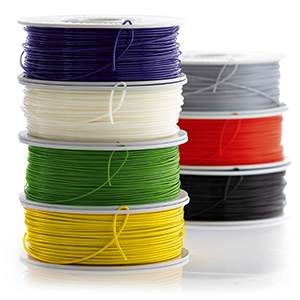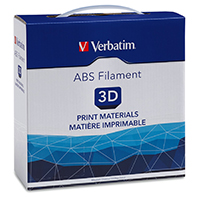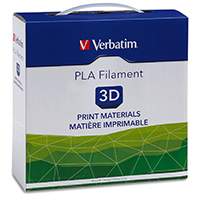Verbatim 3D Printing Filament
Manufactured to very tight tolerances and from the highest quality materials, Verbatim 3D Printing Filament is a durable, impact-resistant filament for use with most commercially available 3D printers. Verbatim 3D Filaments feature a custom spool, designed for strength and balance for uniform feeding. Filaments are packaged in a vacuum-sealed bag, including desiccant, to promote longevity and prevent the introduction of moisture. Verbatim 3D Printing Filaments are backed by a 1-year limited warranty.


| Material |
|
|
| Key Features |
|
|
| Heat Settings |
|
|
| Heated Bed Recommended? |
|
|
| Post Processing |
|
|
| Transparent Options Available? |
|
|
| Recyclability |
|
|
PRIMALLOY Filament
PRIMALLOY Flexible3D Filament is a high performance, polyester based thermoplastic elastomer which consists of a mixture of crystalline aromatic polyester block (mainly PBT) and an uncrystalline polyether block (mainly poly-tetramethylene-ether-glycol). This mixture gives objects printed with PRIMALLOY unique flexibility without sacrificing durability.

How to Select 3D Printing Filament
Filament Diameter
There are two common diameters of 3D printing filament, 1.75 mm and 3.0 mm. Most commercial printers today are designed to work with one diameter filament and not the other. Always check your printer manufacturers specifications to determine which diameter is compatible with your printer. ">
There are two common diameters of 3D printing filament, 1.75 mm and 3.0 mm. Most commercial printers today are designed to work with one diameter filament and not the other. Always check your printer manufacturers specifications to determine which diameter is compatible with your printer. ">
Filament Diameter
There are two common diameters of 3D printing filament, 1.75 mm and 3.0 mm. Most commercial printers today are designed to work with one diameter filament and not the other. Always check your printer manufacturers specifications to determine which diameter is compatible with your printer.
There are two common diameters of 3D printing filament, 1.75 mm and 3.0 mm. Most commercial printers today are designed to work with one diameter filament and not the other. Always check your printer manufacturers specifications to determine which diameter is compatible with your printer.
Precision / Diameter Accuracy
Always look for filament manufacturers who publish their diameter tolerances. The tighter the tolerance, the more consistent and accurate the printed results will be. Verbatim 3D printing filaments are manufactured to a tolerance of +0.05 mm – to ensure stable, accurate prints with consistent feeding. ">
Always look for filament manufacturers who publish their diameter tolerances. The tighter the tolerance, the more consistent and accurate the printed results will be. Verbatim 3D printing filaments are manufactured to a tolerance of +0.05 mm – to ensure stable, accurate prints with consistent feeding. ">
Precision / Diameter Accuracy
Always look for filament manufacturers who publish their diameter tolerances. The tighter the tolerance, the more consistent and accurate the printed results will be. Verbatim 3D printing filaments are manufactured to a tolerance of +0.05 mm – to ensure stable, accurate prints with consistent feeding.
Always look for filament manufacturers who publish their diameter tolerances. The tighter the tolerance, the more consistent and accurate the printed results will be. Verbatim 3D printing filaments are manufactured to a tolerance of +0.05 mm – to ensure stable, accurate prints with consistent feeding.
Spool vs. Coil and Design
Spools are easier to work with than coils. They are easily stored, mount conveniently and distribute the material in an even, consistent manner. However, not all spools are created equal. Verbatim 3D filament spools are custom designed for both strength and to ensure even feeding of filament, resulting in high-quality, consistent printing. ">
Spools are easier to work with than coils. They are easily stored, mount conveniently and distribute the material in an even, consistent manner. However, not all spools are created equal. Verbatim 3D filament spools are custom designed for both strength and to ensure even feeding of filament, resulting in high-quality, consistent printing. ">
Spool vs. Coil and Design
Spools are easier to work with than coils. They are easily stored, mount conveniently and distribute the material in an even, consistent manner. However, not all spools are created equal. Verbatim 3D filament spools are custom designed for both strength and to ensure even feeding of filament, resulting in high-quality, consistent printing.
Spools are easier to work with than coils. They are easily stored, mount conveniently and distribute the material in an even, consistent manner. However, not all spools are created equal. Verbatim 3D filament spools are custom designed for both strength and to ensure even feeding of filament, resulting in high-quality, consistent printing.
Printer Limitations
Is your printer equipped with a heated bed? Is the bed platform capable of achieving 100°C? These are things you should consider when purchasing 3D printing filaments. ABS filament provides much better results when used with a heated print bed - ideally in the range of 80-120°C. The filament will adhere to the print bed better when the bed is heated to temperatures within this range. If your printer is not equipped with a heated print bed, you should consider working with PLA filament. ">
Is your printer equipped with a heated bed? Is the bed platform capable of achieving 100°C? These are things you should consider when purchasing 3D printing filaments. ABS filament provides much better results when used with a heated print bed - ideally in the range of 80-120°C. The filament will adhere to the print bed better when the bed is heated to temperatures within this range. If your printer is not equipped with a heated print bed, you should consider working with PLA filament. ">
Printer Limitations
Is your printer equipped with a heated bed? Is the bed platform capable of achieving 100°C? These are things you should consider when purchasing 3D printing filaments. ABS filament provides much better results when used with a heated print bed - ideally in the range of 80-120°C. The filament will adhere to the print bed better when the bed is heated to temperatures within this range. If your printer is not equipped with a heated print bed, you should consider working with PLA filament.
Is your printer equipped with a heated bed? Is the bed platform capable of achieving 100°C? These are things you should consider when purchasing 3D printing filaments. ABS filament provides much better results when used with a heated print bed - ideally in the range of 80-120°C. The filament will adhere to the print bed better when the bed is heated to temperatures within this range. If your printer is not equipped with a heated print bed, you should consider working with PLA filament.
Printing Environment
As a plant based material, PLA is less prone to fumes than ABS material. Depending on your printing environment, this could be a consideration. However, we recommend always conducting any 3D printing in a well-ventilated environment. ">
As a plant based material, PLA is less prone to fumes than ABS material. Depending on your printing environment, this could be a consideration. However, we recommend always conducting any 3D printing in a well-ventilated environment. ">
Printing Environment
As a plant based material, PLA is less prone to fumes than ABS material. Depending on your printing environment, this could be a consideration. However, we recommend always conducting any 3D printing in a well-ventilated environment.
As a plant based material, PLA is less prone to fumes than ABS material. Depending on your printing environment, this could be a consideration. However, we recommend always conducting any 3D printing in a well-ventilated environment.